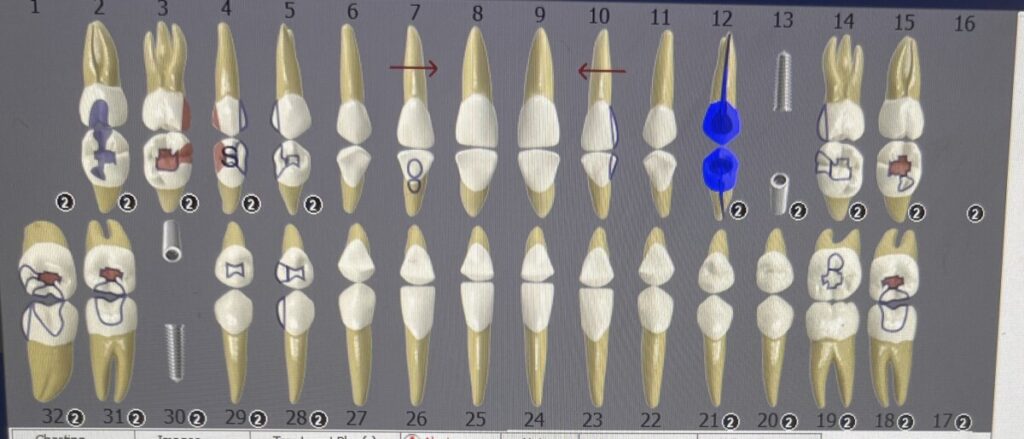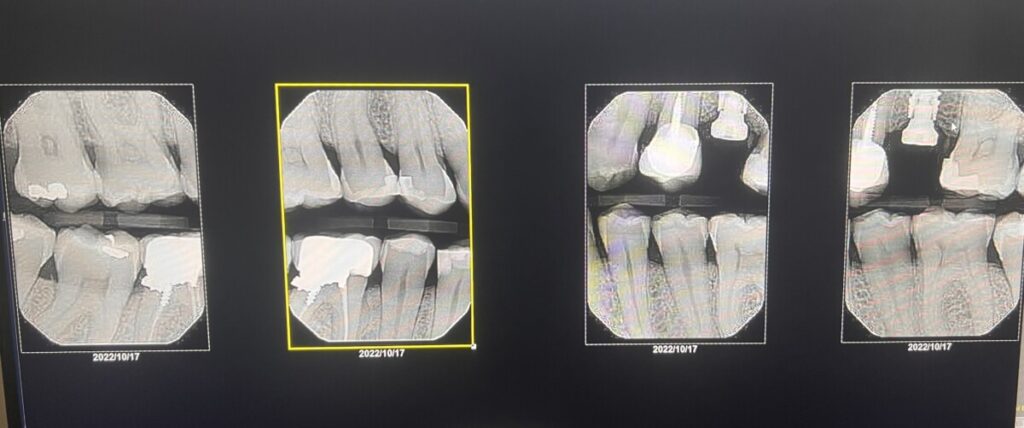Patient profile:
Ms. M is a 54 y.o. African American female presented for a dental cleaning. She is single, a non-smoker, and reports no alcohol or drug use. Additionally, she has no reported allergies.
Chief complaint: “My gums bleed when I brush my teeth”.
Vitals: 129/79 correspond to elevated , Pulse-81. Respiration: 18 breaths/minute. ASA -2.
Med/dental Hx: Her last medical exam was in September 2023, she saw her cardiologist . She has hight blood pressure and takes Losartan 50 mg a day in the morning. The patient had her teeth cleaned in March 2023. Patient states she uses a manual toothbrush 2x/day, toothpaste Colgate with fluoride, flosses 2x/day.
Clinical Findings:
Extraoral/Intraoral findings: Bilateral Submandibular lymph node, asymptomatic
Intraoral Examination: Bilateral Linea Alba. Geographic tongue.
Occlusion: Class I Oclusion: Bilateral. Overjet 30%. Overbite 3mm. Localized attrition on anterior incisors. Diastema on front teeth.
Gingival statement: Pigmented, no stippling, rolled gingival margins and minimal Bleeding on Probing. Generalized moderate marginal gingival inflamations.
Dental Charting:

- Composite restorations: #2-DB, #3-O, #4-MO, #5-DO, #7 L, #10 -D, #14-OM, #18-OB, #19-OL, #28- OD, #29-O, #31-OB, #32- ODB.
- Implant Placement #13
- Root Canal : #12
- Porcelan Crown #12.
- Possible Caries lesions: #3-MO, #4-D, #15-O, #18-O, #31-O, #32-O.
Periodontal Charting:

Periodontal assessment: Generalized 1-3mm PD, localized PD of 4mm on #3M with light BOP. Buccal recession present #19, # 20-28. 29. Mobility/Furcation: Light mobility on #12. Furcation on #31B, Grade I. Attrition on #27-22 and #6,7,9,10,11.
Calc Detection: Localized moderate subgingival calculus with generalized staining on the lingual surfaces.
Utilized 4 HBTW:

Radiographic statement: Gen. 15% horizontal bone loss in the posteriors. Overhanging restoration on #30 D( possible root decay-tooth has since been extracted). Calculus deposit at #12-M. The patient has been informed about their condition and has received a referral for possible decay.
The patient has been referred for evaluation of an enlarged lymph node. This could indicate various underlying issues, ranging from infection to more serious conditions. It’s essential to follow up promptly with the referral to determine the cause and appropriate treatment, ensuring optimal health outcomes for the patient.
PI: 0.83 – Fair.
It’s important to address the potential side effects of medications like Losartan, which may include bleeding gums. Since the patient already has Periodontitis, maintaining good oral hygiene becomes even more crucial to counteract susceptibility to infection.
Dental Hygiene Care Plan:
The patient returned for an additional 2 visits to complete her treatment plan.
Visit 1: All assessments completed. PI/OHI: To address the furcation involvement and generalized gingival inflammation resulting from the patient’s periodontal disease, we have implemented a personalized oral hygiene regimen. This includes introducing the C-shaped flossing method and incorporating the use of a round toothpick in a holder. By adopting the C-shaped flossing technique, our goal is to effectively mitigate inflammation and arrest the progression of bone loss associated with periodontal disease. Given the patient’s geographic tongue condition, emphasize the importance of using a tongue scraper as part of their oral hygiene routine. Tongue scraping helps remove bacteria and debris from the tongue’s surface, which is crucial for maintaining oral health, particularly in individuals with this condition. It can also help alleviate discomfort associated with geographic tongue and reduce the risk of complications. The patient has been provided with a referral. Ultrasonic and hand scaled Q1 and Q4.
Visit 2: Reviewed MH, DH. PI/OHI-based on PI-0.33, the plaque is mostly present on the back teeth, it indicates that these areas might be more challenging for the patient to clean effectively. This could be due to factors such as difficulty reaching those areas with the toothbrush, introduced and demonstrated the modified Bass method of brushing and recommended an electric toothbrush, specifically the Sonicare model. This recommendation is particularly beneficial for the patient due to her gum recession, as the Sonicare brush is known for its gentle yet effective cleaning action, which can help mitigate further recession and maintain oral health. Ultrasonic and hand scale Q2 and Q3. Engine polished with fine paste. A 5% varnish fluoride application was recommended to enhance the patient’s oral health. Fluoride varnish helps to strengthen tooth enamel, making it more resistant to acid attacks from bacteria in the mouth. This can help prevent tooth decay and cavities, especially in areas where the enamel may be weakened, such as around gum recession sites or areas with exposed tooth surfaces. Overall, the application of fluoride varnish is an effective preventive measure to maintain the patient’s dental health and reduce the risk of future oral health issues.
Here are some recommendations:
Dietary Considerations: A balanced diet low in sugary and acidic foods can help maintain oral health and prevent gum disease. While Losartan is effective for managing hypertension, it’s important to monitor and manage any side effects, such as bleeding gums. If the side effects persist or worsen, the patient should consult their healthcare provider for further guidance. Overall, a comprehensive approach to oral hygiene, regular dental care, and monitoring of medication side effects can help manage periodontitis and reduce the risk of infection, especially in patients taking medications like Losartan.
Continued Care Recommendation: The patient has been advised to return for re-care every three months to address their diagnosed periodontitis, as well as the presence of moderate levels of both subgingival and supragingival calculus buildup. This schedule ensures consistent monitoring and management of their periodontal condition, aiding in the prevention of further disease progression and promoting overall oral health.


